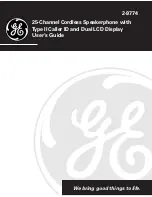
Station Hunting Operation
When a system station user makes an intercom call to the hunt group pilot extension, the system rings the
first available station within the hunt group (based on the group’s selected hunting method). This ringing
appears on the station’s personal intercom. The system ignores all call announce settings as all intercom
calls into a hunt group are treated as voice announce block calls. If the station does not answer the call
within the programmed call advance time limit, the system rings the next station of the group. If no
station answers within the programmed overflow time, the call rings the designated overflow destination.
When a line rings at a hunt group, it rings at the first available station within the group (based on the
group’s selected hunting method). As the ringing line appears at the station, it follows the DXP Plus
conventions for line appearances. If the station does not answer the call within the programmed call
advance time limit, the system rings the next member station. If no station answers within the
programmed overflow time, the system sends the call to the designated overflow destination.
The DXP Plus supports a maximum of 64 hunt groups. Each hunt group can include the maximum
number of stations that the system can support; however, due to system memory limitations, all hunt
groups can not contain all stations simultaneously. Since the system makes a total of 32 Kbytes of
memory available for station hunt groups, you can use the following formula to determine possible station
hunt group capacities.
[32768 Kbytes] – [(Stations per group) x (2) + (220 bytes of memory)] = memory remaining for next hunt
group
Station Message Detail Recording (SMDR)
Station message detail recording provides a record of the incoming and outgoing calls handled by the
system on selected lines. This record provides information for accounting and traffic analysis studies.
When enabled, SMDR is invoked automatically. The SMDR feature generates a call record for printing
as soon as it is collected by the system. The call record is presented as ASCII data in an eighty-column
format to an RS-232 data port located on the central processor unit circuit board. SMDR requires
customer-provided equipment such as a printer or other compatible data recording device.
Also see the discussion titled Call Costing and SMDA Reports.
Station Monitoring With DSS Call Pick Up
Refer to the discussion titled Intercom Number.
DXP Plus General Description
GCA40–130
Understanding The Features – 103
Содержание DXP Plus Series
Страница 1: ...Digital Communications System R ...
Страница 363: ...Automatic Call Distributor Technical Manual R QuickQ DXP ...
Страница 424: ...Automatic Call Distributor System Manager s Guide R QuickQ DXP ...
Страница 500: ...Wrap up Time 1 6 Wrapping Up A Call 4 3 Z Zoom Box A 2 GCA70 271 Index I 3 ...
Страница 628: ...Interconnecting The VMI X Installing And Programming For ExecuMail IMI89 206 Installing And Programming For ExecuMail 5 ...
Страница 677: ...Connecting The Equipment Installing And Programming The OPX X IMI89 209 Installing The OPX X 7 ...
Страница 728: ...DP I I I I and FX Series Digital Communications Systems Understanding The Visual Man Machine Interface COMDlA ...
Страница 1112: ...9 08 8 90 1 13 4 78 3 94 UNIS029 TAB003 PLS page 6 GCA40 130 DXP Plus General Description 11B Telephone Features ...















































